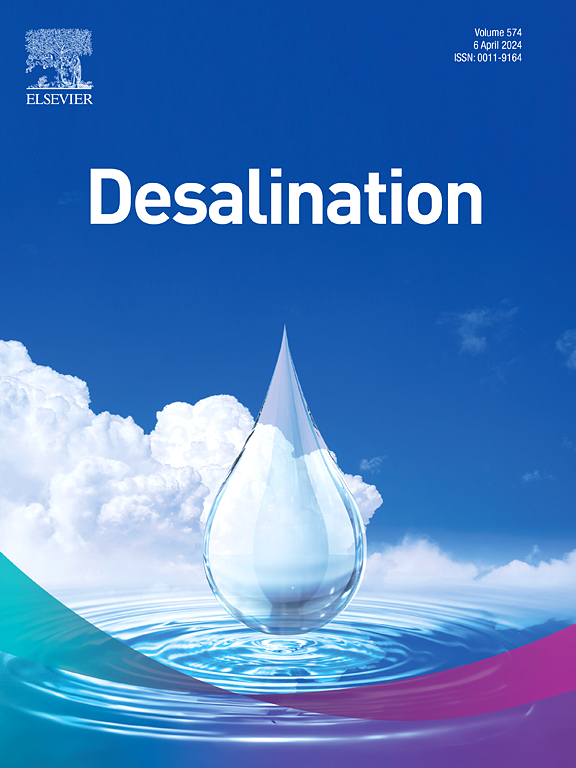Effect of Na+ solvation behavior on evaporation processes in solar-driven interfacial evaporation systems
IF 9.8
1区 工程技术
Q1 ENGINEERING, CHEMICAL
引用次数: 0
Abstract
Solar-driven interfacial evaporation (SDIE) systems, as energy-efficient and innovative water treatment technologies, face a critical challenge: their evaporation efficiency is markedly influenced by the microscopic state of water molecules in saline solutions, such as hydrogen-bond networks and ion hydration behavior. This study investigates the dissolution behavior of sodium ions (Na+) and its regulatory mechanism on SDIE performance through molecular dynamics (MD) simulations and density functional theory (DFT) calculations, revealing that Na+ ions form stable [Na(H2O)5]+ hydration clusters via coordination with five water molecules. Within these clusters, coordinated water molecules lose approximately 0.11 electrons, inducing structural distortions characterized by elongation of the O![]() H bond length from 0.970 Å (free water) to 0.972 Å (coordinated water), expansion of the H-O-H bond angle from 102.59° to 103.47°, and reduction of the O
H bond length from 0.970 Å (free water) to 0.972 Å (coordinated water), expansion of the H-O-H bond angle from 102.59° to 103.47°, and reduction of the O![]() H bond order from 0.872 (free water) to 0.841 (coordinated water), collectively weakening hydrogen bond strength and enhancing the chemical reactivity of coordinated water. Fourier-transform infrared (FTIR) spectroscopy further demonstrates that increasing salt concentration in NaCl solutions triggers a red shift in the O
H bond order from 0.872 (free water) to 0.841 (coordinated water), collectively weakening hydrogen bond strength and enhancing the chemical reactivity of coordinated water. Fourier-transform infrared (FTIR) spectroscopy further demonstrates that increasing salt concentration in NaCl solutions triggers a red shift in the O![]() H stretching vibration peak (v(O
H stretching vibration peak (v(O![]() H)), indicative of weakened hydrogen-bond networks. However, the strong binding energy between Na+ and water molecules (−25.79 kcal·mol−1), significantly surpassing the intermolecular interaction energy between water molecules (−3.97 kcal·mol−1), suppresses evaporation rates by approximately 18 % through a hydration‑hydrogen bond competition mechanism. By elucidating these molecular-scale regulatory effects of salt ions on SDIE systems, this study establishes a theoretical foundation for optimizing evaporation efficiency in high-salinity environments.
H)), indicative of weakened hydrogen-bond networks. However, the strong binding energy between Na+ and water molecules (−25.79 kcal·mol−1), significantly surpassing the intermolecular interaction energy between water molecules (−3.97 kcal·mol−1), suppresses evaporation rates by approximately 18 % through a hydration‑hydrogen bond competition mechanism. By elucidating these molecular-scale regulatory effects of salt ions on SDIE systems, this study establishes a theoretical foundation for optimizing evaporation efficiency in high-salinity environments.

太阳驱动界面蒸发系统中Na+溶剂化行为对蒸发过程的影响
太阳能驱动界面蒸发(SDIE)系统作为一种高效节能的创新水处理技术,面临着一个严峻的挑战:其蒸发效率受到盐水溶液中水分子微观状态(如氢键网络和离子水化行为)的显著影响。本研究通过分子动力学(MD)模拟和密度泛函理论(DFT)计算研究了钠离子(Na+)的溶解行为及其对SDIE性能的调控机制,揭示了Na+离子通过与5种水分子配合形成稳定的[Na(H2O)5]+水合团簇。在这些团簇中,配位水分子失去了约0.11个电子,导致OH键长度从0.970 Å(自由水)延长到0.972 Å(配位水),H-O-H键角从102.59°扩展到103.47°,OH键序从0.872(自由水)降低到0.841(配位水)的结构扭曲,共同削弱了氢键强度,增强了配位水的化学反应活性。傅里叶红外(FTIR)光谱进一步表明,NaCl溶液中盐浓度的增加会引发OH拉伸振动峰(v(OH))的红移,表明氢键网络减弱。然而,Na+与水分子之间的强结合能(- 25.79 kcal·mol−1)明显超过水分子之间的分子间相互作用能(- 3.97 kcal·mol−1),通过水合氢键竞争机制抑制了约18%的蒸发速率。通过阐明盐离子对SDIE系统的分子调控作用,本研究为优化高盐度环境下的蒸发效率奠定了理论基础。
本文章由计算机程序翻译,如有差异,请以英文原文为准。
求助全文
约1分钟内获得全文
求助全文
来源期刊

Desalination
工程技术-工程:化工
CiteScore
14.60
自引率
20.20%
发文量
619
审稿时长
41 days
期刊介绍:
Desalination is a scholarly journal that focuses on the field of desalination materials, processes, and associated technologies. It encompasses a wide range of disciplines and aims to publish exceptional papers in this area.
The journal invites submissions that explicitly revolve around water desalting and its applications to various sources such as seawater, groundwater, and wastewater. It particularly encourages research on diverse desalination methods including thermal, membrane, sorption, and hybrid processes.
By providing a platform for innovative studies, Desalination aims to advance the understanding and development of desalination technologies, promoting sustainable solutions for water scarcity challenges.
 求助内容:
求助内容: 应助结果提醒方式:
应助结果提醒方式:


